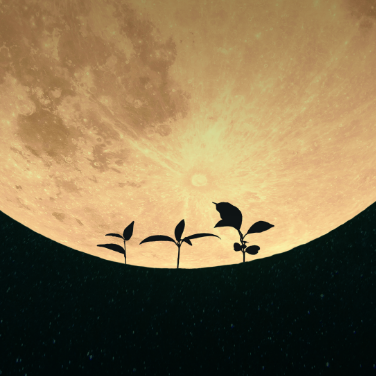First Plants Grown in Lunar Soil May Lead to Farming in Space
By Mark Miller
Researchers at the University of Florida Institute of Food and Agricultural Sciences are the first to successfully grow plants in lunar soil brought back by the Apollo space missions. The lab-grown garden—part of research supporting the ambitious Artemis program at the National Aeronautics and Space Administration (NASA)—marks an important step toward growing plants and food on the moon and possibly worlds beyond.
Tough Growing
Dirt from the moon is a challenging environment for plant growth. According to an article in Science News, lunar soil, known as regolith, is a fine powder full of metallic iron, which, unlike oxidized iron, isn’t beneficial to plants. It also contains tiny shards of glass as a result of the moon’s surface being continually struck by micrometeorites. What it doesn’t contain much of is nitrogen, phosphorus, or other nutrients.
The research team chose thale cress or Arabidopsis thaliana to grow in this unwelcoming world. It’s a relative of mustard greens and other cruciferous vegetables like broccoli and cauliflower. A small, hardy plant that grows easily, thale cress is also the model organism used in multiple studies of plant biology, which means scientists have a good understanding of its genetic makeup.
The team combined thale cress seeds and water with gram-sized samples of soil from the Apollo 11, 12, and 17 missions. These were placed in terrarium boxes under LED lights in a cleanroom. They also planted control samples in terrestrial volcanic material and added a nutrient to all of the samples daily.
“After two days, they started to sprout!” said Anna-Lisa Paul, PhD, a professor of horticultural sciences at the University of Florida and part of the research team, in a report from NASA. “Everything sprouted. I can’t tell you how astonished we were! Every plant—whether in a lunar sample or in a control—looked the same up until about day six.”
"Everything sprouted. I can’t tell you how astonished we were!"
Better Plots and Plants
As Dr. Paul’s reaction indicates, both sample sets did not grow equally well. After about a week, the growth of the lunar samples slowed. They had stunted roots and leaves and an unhealthy, purplish pigmentation.
To better understand what had happened, the team conducted genetic analysis by studying the ribonucleic acid (RNA) from the plants grown in the moon soil. RNA transforms information from deoxyribonucleic acid (DNA) into proteins that carry out many of a living organism’s biological processes. Examination of the RNA sequence of the plants’ cells revealed that the thale cress was reacting as it typically does when the environment contains too much salt or heavy metals.
The plants had the most trouble growing in the soil samples from Apollo 11, perhaps because these were drawn from the moon’s Sea of Tranquility, according to an NBC News story. This region, according to the story, is an older surface of the moon and has experienced greater cosmic radiation and solar wind.
A correlation between the age of the lunar soil and the performance of the plants may help future moon gardeners know where—or where not—to collect their planting soil. It may also help to select plants better suited to moon dirt. “Maybe spinach plants, which are very salt-tolerant, would have no trouble growing in lunar regolith,” wondered Dr. Paul in Science News.
One Small Step
Although the lunar samples didn’t produce growth as well as the volcanic soil, the research is a dramatic initial success that significantly advances the role of plant life in space exploration and habitation.
Plants can be used as model organisms to help study gravity, radiation, and other biological phenomena in space, according to a paper the University of Florida team published in Nature. It points out that plants help us understand how biological organisms adapt away from Earth and could provide food and oxygen to support long-term habitation of space and even extraterrestrial surfaces. Using moon regolith could prove much more practical than transporting enough water to support hydroponic agriculture.
Returning to Space
The work done at the University of Florida is picking up where NASA left off. Over the course of their missions, Apollo crews returned to Earth with 842 pounds of moon rocks and soil. The plantings are making good use of these materials. “Here we are, 50 years later, completing experiments that were started back in the Apollo labs,” said Robert Ferl, PhD, another member of the University of Florida team, in the NASA report.
The research plays a central role in the success of the Artemis program, which aims to return astronauts to the moon and establish a long-term presence there. Ultimately, its lunar missions will serve as a leaping-off point for human exploration of Mars.
Mark Miller is a Thermo Fisher Scientific staff writer.
